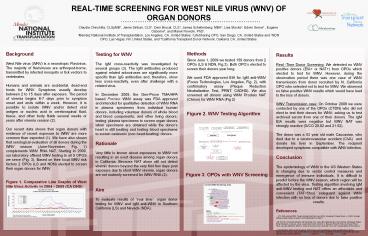RISK ASSESSMENT OF TRANSPLANTING RENAL ALLOGRAFTS - PowerPoint PPT Presentation
1 / 1
Title: RISK ASSESSMENT OF TRANSPLANTING RENAL ALLOGRAFTS
1
REAL-TIME SCREENING FOR WEST NILE VIRUS (WNV) OF
ORGAN DONORS
Claudia Chinchilla, CLSpMB1, Jaime Siriban, CLS1,
Dem Brucal, CLS1, James Schellenberg, MBA1, Lisa
Stocks2, Edwin Serna3 , Eugene Osborne4, and
Marek Nowicki, PhD1. 1Mendez National Institute
of Transplantation, Los Angeles, CA, United
States 2LifeSharing OPO, San Diego, CA, United
States and 3NDN OPO, Las Vegas, NV, United
States, and 4California Transplant Donor Network,
Oakland, CA, United States
Methods Since June 1, 2009 we tested 159 donors
from 2 OPOs (LS NDN, Fig.3). Both OPOs elected
to screen their donors year long. We used FDA
approved EIA for IgM anti-WNV (Focus
Technologies, Los Angeles, Fig. 2), with
confirmatory assay (Plaque Reduction
Neutralization Test, PRNT, CADHS). We also
screened all donors using WNV Procleix NAT
(Chiron) for WNV RNA (Fig 2)
Background West Nile virus (WNV) is a
neurotropic Flavivirus. The majority of
flaviviruses are arthropod-borne, transmitted by
infected mosquito or tick vectors to vertebrates.
Humans and animals are accidental, dead-end
hosts for WNV. Symptoms usually develop between 2
to 15 days after exposure. The period of viremia
begins 6-7 days prior to symptom onset and ends
within a week. However, it is possible to isolate
WNV and/or detect viral antigen or nucleic acid
in cerebrospinal fluid, tissue, and other body
fluids several weeks or years after viremia
cession (2). Our recent data shows that organ
donors with evidence of recent exposure to WNV
are more common than expected (1). We have also
shown that serological evaluation of all donors
during the WNV season (June-November, Fig. 1)
complements WNV RNA NAT. Starting in 2009, our
laboratory offered WNV testing to all 9 OPOS we
serve (Fig. 3). Based on their local WNV risk
factors 2 OPOs (LS and NDN) elected to screen
their organ donors for WNV. Figure 1.
Comparative Line Graphs of West Nile Virus
Activity in 2004 - 2009 (CA DHS)
Testing for WNV The IgM cross-reactivity was
investigated by several groups (3). The IgM
antibodies produced against related arboviruses
are significantly more specific than IgG
antibodies and, therefore, show less
cross-reactivity, even after challenge with a
related virus. In December 2005, the Gen-Prove
TMA/HPA based Procleix WNV assay was FDA approved
and intended for qualitative detection of WNV RNA
in plasma specimens from individual human donors,
including volunteer donors of whole blood and
blood components, and other living donors
testing plasma specimens to screen organ donors
when specimens are obtained while the donors
heart is still beating and testing blood
specimens to screen cadaveric (non-heart-beating)
donors. Rationale Very little is known about
exposures to WNV not resulting in an overt
disease among organ donors in California. Because
NAT alone will not detect viremic donors beyond
the very first few days post exposure due to
short WNV viremia, organ donors are not routinely
screened for WNV RNA.(2). Aim To evaluate
results of real time organ donor testing for
WNV and IgM anti-WNV in Southern California (LS)
and Nevada (NDA).
- Results
- Real -Time Donor Screening We detected no WNV
positive donors (EIA or NAT) from OPOs which
elected to test for WNV. However, during the
observation period there was one case of WNV
transmission from donor recruited by N.
California OPO who selected not to test for WNV.
We observed no false positive WNV results which
would have lead to the loss of donors. - WNV Transmission case On October 2009 we were
contacted by one of the OPOs (CTDN) who did not
elect to test their donors for WNV asking us to
test archived serum from one of their donors. The
IgM EIA results were negative but WNV NAT was
strongly reactive (S/CO 20.82 and 21.52). - The donor was a 53 year old male Caucasian, who
died due to a cerebrovascular accident (CVA) and
donate his liver in September. The recipient
developed symptoms compatible with WNV infection.
- Conclusion
- The epidemiology of WNV in the US Western States
is changing due to vector control measures and
emergence of immune individuals. It is difficult
to predict before the WNV season, which region
will be affected by the virus. Testing algorithm
involving IgM anti-WNV testing and NAT offers an
affordable and convenient (TATlt5hrs) safeguard
against WNV infection with no loss of donors due
to false positive results. - References
- ATC 2009, abstract 992. Toward rational West
Nile Virus (WNV) Screening of Organ Donors Is
WNV Serology Testing a Viable Option to Nucleic
Acid Testing (NAT) for WNV? - JID 2010201, Persistent Infection with West Nile
Virus Years after Initial Infection, Kristy
Murray, Christopher Walker, Emily Herrington,
Jessica A. Lewis, Joseph McCormick, David W. C.
Beasley, Robert B. Tesh, and Susan Fisher-Hoch
see also editorial by Ernest A. Gould in the same
issue, West Nile Virus Dont Underestimate Its
Persistence - J Clin Microbiol. 2004 Oct42(10)4641-8.
Performance of immunoglobulin G (IgG) and IgM
enzyme-linked immunosorbent assays using a West
Nile virus recombinant antigen (preM/E) for
detection of West Nile virus- and other
flavivirus-specific antibodies, Hogrefe WR, Moore
R, Lape-Nixon M, Wagner M, Prince HE.
Figure 2. WNV Testing Algorithm
Figure 3. OPOs with WNV Screening































